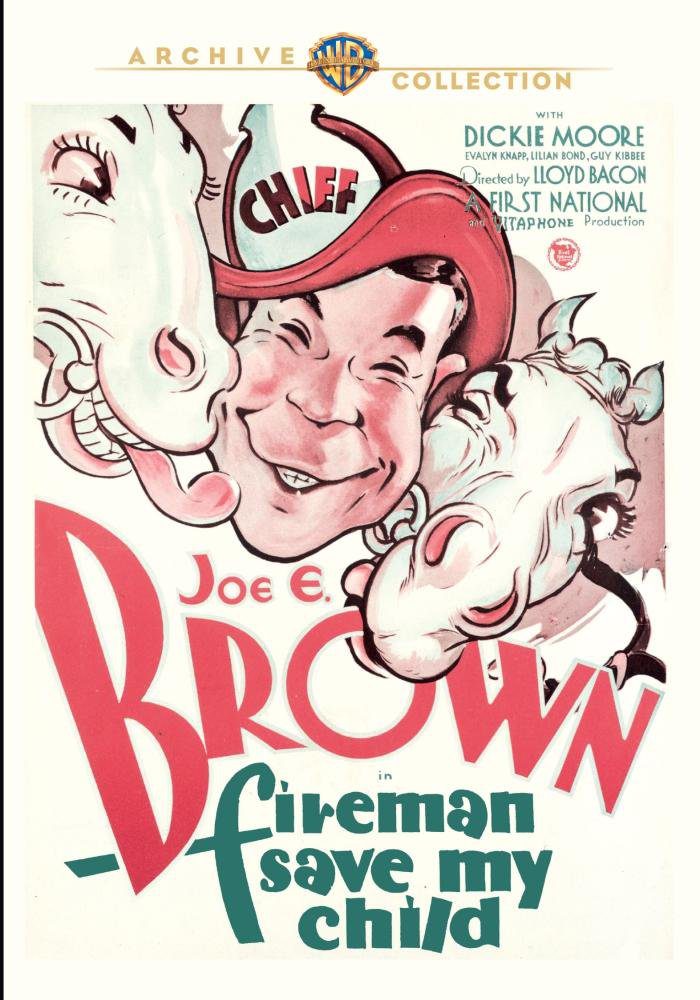
Admittedly, a movie from the early ’30s is bound to feel more than just a tad bit outdated when viewed today. That said, Lloyd Bacon’s Fireman, Save My Child ‒ a First National Pictures comedy starring the mouth himself, Joe E. Brown ‒ was already old hat (or old fire helmet, as it were) when it was released by Warner Bros. in late February of 1932, as it had already been made twice before during the Silent Era.
The first film to carry the title was Hal Roach’s one-reel short from 1918 with the great Harold Lloyd in the lead, which, in all honesty, wasn’t too far removed from the sort of antics you’d expect from Mack Sennett’s Keystone Cops. Only with a horse-drawn fire truck. In 1927, Paramount released a feature-length variation starring Wallace Beery and his infrequent on-screen comedic partner, Raymond Hatton. That version found its lead characters getting called to the home of the fire chief’s spoiled daughter to do all of her housework for her (something emergency responders tend to frown upon today).
But it wasn’t until Bacon’s flick in 1932 that audiences saw the most ridiculous take on such a scenario yet, wherein they somehow managed to make it into a baseball comedy! In fact, it would prove to be the first of a “baseball trilogy” starring iconic comedian Joe E. Brown, which continued with Elmer the Great (1933) and concluded with Alibi Ike (1935). Unlike most trilogies, the final contribution turned out to be the best-loved of the three pictures (practice makes perfect?). Meanwhile, this, the filmic genesis of the cycle, remains at the bottom of the barrel. And rightfully so.
Here, Brown plays a rural town fireman named “Smokey” Joe. In addition to being a firefighter with a near-fetishistic devotion to his profession, Joe is also an avid inventor, having recently perfected a baseball-shaped fire bomb ‒ which you throw, like a ball, naturally ‒ capable of putting out flames in a flash. Alas, Joe is also a complete and utter nincompoop who leaves his beloved fiancee Sally (Evalyn Knapp, The Perils of Pauline, Mr. Smith Goes to Washington) behind in their tiny horse-drawn fire truck town in order to accept a generous offer from the St. Louis Cardinals.
Accepting the pro-ball gig, Joe plans to use his newfound gains to patent his invention. Unfortunately for everyone concerned ‒ the average viewer included ‒ Joe gets sidetracked and played by the preying hands of beautiful blonde vixen June (Lillian Bond). This leads to some extremely below-average situational comedy-type material as dimwitted Joe fails to play the (dating) field, the scenario of which is poorly constructed to begin with, before our idiot hero manages to set fire to an office to prove his invention works.
Judging by the prominent billing of child star Dickie Moore on the original poster art, Fireman, Save My Child must have been severely edited in post-production, as the appearance of the said performer is all but limited to a brief cameo. Presumably, Moore must have been the child in need of saving, since there is no other such moment in the entire film worthy of the title. It’s baffling, to say the least, but there is really no reason to waste one’s time trying to solve the mystery, as Fireman, Save My Child isn’t the sort of picture classic comedy and/or Joe E. Brown fans should bother with.
(The same is generally said of the 1954 version of Fireman, Save My Child from Universal Pictures with novelty musician Spike Jones highlighting the surely cringe-worthy antics of Buddy Hackett and Hugh O’Brien, the latter of whom were last-minute replacements for an absent Abbott & Costello. Viewed at with this particular bit of useless information taken into consideration, Lloyd Bacon’s childless sports comedy variation may actually be the better production. Alas, the ’54 take has never seen the light of day on any home media format. Which could very well be a major blessing.)
The Warner Archive Collection bats Fireman, Save My Child out of the vault via a 1.37:1 (or whereabouts) presentation culled from the best surviving materials. Both the picture and mono audio are about as good as they can be for an 86-year-old feature (the jokes are just as fresh), and the MOD DVD-R release features absolutely nothing in the way of bonus materials.